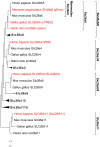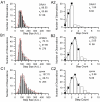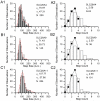The conserved tetrameric subunit stoichiometry of Slc26 proteins
- PMID: 23642772
- PMCID: PMC3767988
- DOI: 10.1017/S1431927613000457
The conserved tetrameric subunit stoichiometry of Slc26 proteins
Abstract
The Slc26 family proteins, with one possible exception, transport anions across membranes in a wide variety of tissues in vertebrates, invertebrates, and plants. Mutations in human members of the family are a significant cause of disease. Slc26 family proteins are thought to be oligomers, but their stoichiometry of association is in dispute. A recent study, using sequential bleaching of single fluorophore-coupled molecules in membrane fragments, demonstrated that mammalian Slc26a5 (prestin) is a tetramer. In this article, the stoichiometry of two nonmammalian prestins and three human SLC26 proteins has been analyzed by the same method, including the evolutionarily-distant SLC26A11. The analysis showed that tetramerization is common and likely to be ubiquitous among Slc26 proteins, at least in vertebrates. The implication of the findings is that tetramerization is present for functional reasons.
Figures





Similar articles
-
Functional regulation of the SLC26-family protein prestin by calcium/calmodulin.J Neurosci. 2014 Jan 22;34(4):1325-32. doi: 10.1523/JNEUROSCI.4020-13.2014. J Neurosci. 2014. PMID: 24453323 Free PMC article.
-
Conserved dimeric subunit stoichiometry of SLC26 multifunctional anion exchangers.J Biol Chem. 2008 Feb 15;283(7):4177-88. doi: 10.1074/jbc.M704924200. Epub 2007 Dec 11. J Biol Chem. 2008. PMID: 18073211
-
Nonmammalian orthologs of prestin (SLC26A5) are electrogenic divalent/chloride anion exchangers.Proc Natl Acad Sci U S A. 2007 May 1;104(18):7693-8. doi: 10.1073/pnas.0608583104. Epub 2007 Apr 18. Proc Natl Acad Sci U S A. 2007. PMID: 17442754 Free PMC article.
-
SLC26 chloride/base exchangers in the kidney in health and disease.Semin Nephrol. 2006 Sep;26(5):375-85. doi: 10.1016/j.semnephrol.2006.07.005. Semin Nephrol. 2006. PMID: 17071331 Review.
-
The SLC26 gene family of multifunctional anion exchangers.Pflugers Arch. 2004 Feb;447(5):710-21. doi: 10.1007/s00424-003-1090-3. Epub 2003 May 21. Pflugers Arch. 2004. PMID: 12759755 Review.
Cited by
-
Systematic quantification of the anion transport function of pendrin (SLC26A4) and its disease-associated variants.Hum Mutat. 2020 Jan;41(1):316-331. doi: 10.1002/humu.23930. Epub 2019 Oct 26. Hum Mutat. 2020. PMID: 31599023 Free PMC article.
-
Functional regulation of the SLC26-family protein prestin by calcium/calmodulin.J Neurosci. 2014 Jan 22;34(4):1325-32. doi: 10.1523/JNEUROSCI.4020-13.2014. J Neurosci. 2014. PMID: 24453323 Free PMC article.
-
Engineering the cyanobacterial ATP-driven BCT1 bicarbonate transporter for functional targeting to C3 plant chloroplasts.J Exp Bot. 2024 Aug 28;75(16):4926-4943. doi: 10.1093/jxb/erae234. J Exp Bot. 2024. PMID: 38776254 Free PMC article.
-
Mechanism and synergism in epithelial fluid and electrolyte secretion.Pflugers Arch. 2014 Aug;466(8):1487-99. doi: 10.1007/s00424-013-1390-1. Epub 2013 Nov 16. Pflugers Arch. 2014. PMID: 24240699 Free PMC article. Review.
-
Prestin kinetics and corresponding frequency dependence augment during early development of the outer hair cell within the mouse organ of Corti.Sci Rep. 2019 Nov 11;9(1):16460. doi: 10.1038/s41598-019-52965-1. Sci Rep. 2019. PMID: 31712635 Free PMC article.
References
-
- CURRALL B, JENSEN-SMITH H, HALLWORTH R. Homo- and hetero-oligomerization in the Slc26a protein family. In: Shera CA, Olson ES, editors. What Fire is in Mine Ears: Progress in Auditory Biomechanics. American Institute of Physics; Melville, NY: 2011a. pp. 148–153.
Publication types
MeSH terms
Substances
Grants and funding
LinkOut - more resources
Full Text Sources
Other Literature Sources

